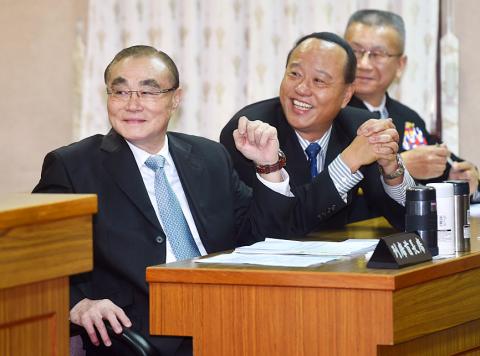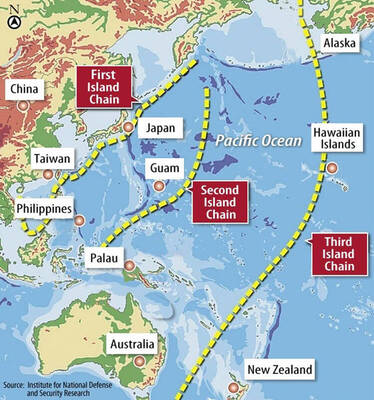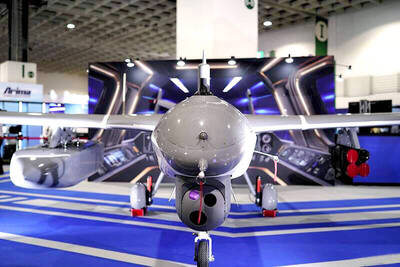The Ministry of National Defense plans to acquire new-generation stealth fighter jets with short or vertical takeoff and landing capabilities to deter Chinese military action against Taiwan, it said in its Quadrennial Defense Review released yesterday.
The military plans to procure the jets to improve its asymmetrical capabilities, as the cross-strait military balance has increasingly tilted in China’s favor, the report said.
It also plans to develop indigenous submarines and upgrade surface vessels, improve air-defense missile and road-mobile missile systems, and establish a fleet of uncrewed aerial combat vehicles.

Photo: Chien Jung-fong, Taipei Times
Any jets capable of short or vertical takeoff and landing could be the ministry’s target, including, but not exclusively, the Lockheed Martin F-35, Deputy Minister of National Defense Lee Hsi-ming (李喜明) said during a question-and-answer session at the legislature’s Foreign Affairs and National Defense Committee meeting in Taipei.
The ministry disputed reports that AGM-154 Joint Standoff Weapon systems and AGM-88 high-speed anti-radiation missiles are in an arms package for Taiwan to be approved by US President Donald Trump following his meeting with Chinese President Xi Jinping (習近平), which is scheduled for early next month in Florida.
“All those claims are media speculation,” ministry spokesman Major General Chen Chung-chi (陳中吉) said. “The nation would carefully assess [what weapons are necessary] according to regional threats and defense requirements.”
The report presents defense guidelines for a “solid defense and multi-layered deterrents,” aiming to deter the enemy from waging war and, if deterrence fails, to launch a series of counterstrikes to destroy the incoming enemy at sea or on beaches.
“With the rapid growth of China’s defense budget, the People’s Liberation Army has made considerable progress to modernize and reform its military,” the review said. “It has the ability to blockade Taiwan, launch combined operations, and seize and hold Taiwan’s outlying islands.”
Lieutenant General Chiang Chen-chung (姜振中), director of the ministry’s Office for Operations and Planning, said the armed forces have the capability to launch a counteroffensive and attack China if necessary.
Asked if the armed forces could defend against multiple attacks launched from bases as far as 1,300km from Taiwan, Chiang said the military “has such ability and there are plans and training in place.”
Legislators said the report was overwhelmingly similar to the 2013 review and the ministry had failed to clarify its plans to acquire advanced weapons or develop the local defense industry.
Democratic Progressive Party (DPP) Legislator Tsai Shih-ying (蔡適應) said there was little difference between the two reports in terms of the air force’s capabilities and cybersecurity measures.
Chinese Nationalist Party (KMT) Legislator Hsu Yu-jen (許毓仁) and DPP Legislator Chuang Jui-hsiung (莊瑞雄) said the review failed to expound on the ministry’s efforts to build a cyberwarfare command as a fourth branch of the military.
Major General Li Ting-sheng (李廷盛), director of the ministry’s Office for Communications, Electronics and Information, said that a cyberwarfare unit would be set up in the second half of this year to protect the military’s command, control, communications, computers, intelligence, surveillance and reconnaissance systems, as well as key infrastructure.
Plans to develop a local defense industry, in particular the aerospace, shipbuilding and information security sectors, is what distinguishes this year’s review from previous ones, the ministry said.
Meanwhile, Minister of National Defense Feng Shih-kuan (馮世寬) said that a small defense budget and increasing difficulty in maintaining an all-voluntary force as the nation’s birth rate declines are the biggest hurdles to improving the nation’s defensive capabilities.
Defense spending should be increased to 3 percent of the GDP, but the defense budget for this year of NT$355.7 billion (US$11.6 billion) is only 2.05 percent of GDP, Feng said.

The US government has signed defense cooperation agreements with Japan and the Philippines to boost the deterrence capabilities of countries in the first island chain, a report by the National Security Bureau (NSB) showed. The main countries on the first island chain include the two nations and Taiwan. The bureau is to present the report at a meeting of the legislature’s Foreign Affairs and National Defense Committee tomorrow. The US military has deployed Typhon missile systems to Japan’s Yamaguchi Prefecture and Zambales province in the Philippines during their joint military exercises. It has also installed NMESIS anti-ship systems in Japan’s Okinawa

‘WIN-WIN’: The Philippines, and central and eastern European countries are important potential drone cooperation partners, Minister of Foreign Affairs Lin Chia-lung said Minister of Foreign Affairs Lin Chia-lung (林佳龍) in an interview published yesterday confirmed that there are joint ventures between Taiwan and Poland in the drone industry. Lin made the remark in an exclusive interview with the Chinese-language Liberty Times (the Taipei Times’ sister paper). The government-backed Taiwan Excellence Drone International Business Opportunities Alliance and the Polish Chamber of Unmanned Systems on Wednesday last week signed a memorandum of understanding in Poland to develop a “non-China” supply chain for drones and work together on key technologies. Asked if Taiwan prioritized Poland among central and eastern European countries in drone collaboration, Lin

NO CONFIDENCE MOTION? The premier said that being toppled by the legislature for defending the Constitution would be a democratic badge of honor for him Premier Cho Jung-tai (卓榮泰) yesterday announced that the Cabinet would not countersign the amendments to the local revenue-sharing law passed by the Legislative Yuan last month. Cho said the decision not to countersign the amendments to the Act Governing the Allocation of Government Revenues and Expenditures (財政收支劃分法) was made in accordance with the Constitution. “The decision aims to safeguard our Constitution,” he said. The Constitution stipulates the president shall, in accordance with law, promulgate laws and issue mandates with the countersignature of the head of the Executive Yuan, or with the countersignatures of both the head of the Executive Yuan and ministers or

CABINET APPROVAL: People seeking assisted reproduction must be assessed to determine whether they would be adequate parents, the planned changes say Proposed amendments to the Assisted Reproduction Act (人工生殖法) advanced yesterday by the Executive Yuan would grant married lesbian couples and single women access to legal assisted reproductive services. The proposed revisions are “based on the fundamental principle of respecting women’s reproductive autonomy,” Cabinet spokesperson Michelle Lee (李慧芝) quoted Vice Premier Cheng Li-chiun (鄭麗君), who presided over a Cabinet meeting earlier yesterday, as saying at the briefing. The draft amendment would be submitted to the legislature for review. The Ministry of Health and Welfare, which proposed the amendments, said that experts on children’s rights, gender equality, law and medicine attended cross-disciplinary meetings, adding that